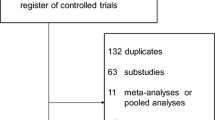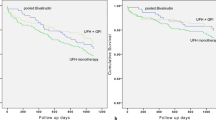Abstract
Aim
The efficacy and safety of bivalirudin when used concurrently with glycoprotein IIb/IIIa inhibitors (GPI) is uncertain. In this systematic review and meta-analysis, we aimed to evaluate the efficacy and safety of bivalirudin versus heparin in patients with ST-segment elevation myocardial infarction (STEMI) undergoing primary percutaneous coronary intervention (PCI) and to explore the impact of differential use (greater and balanced) of GPI.
Methods
Online databases were queried from inception to March 2023 to identify eight randomized controlled trials (n = 22,483) for inclusion. The primary outcomes included all-cause mortality, major bleeding, major adverse cardiovascular events (MACE), and net adverse clinical events (NACE). Secondary efficacy endpoints included cardiac death, reinfarction, stent thrombosis (ST), and stroke. Data were pooled using a random-effects model to derive risk ratios (RRs) and 95% confidence intervals (CIs).
Results
When compared to heparin, bivalirudin was associated with a significant reduction in all-cause mortality (RR 0.83; 95% CI 0.72–0.97; P = 0.02), major bleeding (RR 0.73; 95% CI 0.57–0.93; P = 0.01), cardiac death (RR 0.79; 95% CI 0.66–0.94; P = 0.01), and NACE (RR 0.80; 95% CI 0.72–0.89; P < 0.0001). However, while the bivalirudin arm showed an increased likelihood of ST in the greater GPI subgroup (RR 1.70; 95% CI 1.13–2.56; P = 0.01), it was associated with a decreased likelihood of ST in the balanced GPI subgroup (RR 0.40; 95% CI 0.24–0.65; P = 0.0003).
Conclusion
Overall, our findings suggest that bivalirudin may be a more efficacious intervention than heparin for reducing certain adverse events in patients with STEMI undergoing primary PCI.






Similar content being viewed by others
References
Corbett SJ, Ftouh S, Lewis S et al. Acute coronary syndromes: summary of updated NICE guidance. BMJ 2021;372, DOI: https://doi.org/10.1136/BMJ.M4760.
Jafary FH. Anticoagulants and Primary PCI. Primary Angioplasty 2018:109–18.
Roffi M, Patrono C, Collet J-P, et al. 2015 ESC Guidelines for the management of acute coronary syndromes in patients presenting without persistent ST-segment elevation Task Force for the Management of Acute Coronary Syndromes in Patients Presenting without Persistent ST-Segment Elevation of the European Society of Cardiology (ESC). Eur Heart J. 2016;37:267–315.
Ibanez B, James S, Agewall S, et al. 2017 ESC Guidelines for the management of acute myocardial infarction in patients presenting with ST-segment elevation: The Task Force for the management of acute myocardial infarction in patients presenting with ST-segment elevation of the European Society of Cardiology (ESC). Eur Heart J. 2018;39:119–77.
Collet J-P, Thiele H, Barbato E, et al. 2020 ESC Guidelines for the management of acute coronary syndromes in patients presenting without persistent ST-segment elevationThe Task Force for the management of acute coronary syndromes in patients presenting without persistent ST-segment elevation of the European Society of Cardiology (ESC). Eur Heart J. 2021;42:1289–367.
Stone GW, Witzenbichler B, Guagliumi G, et al. Bivalirudin during Primary PCI in Acute Myocardial Infarction. N Engl J Med. 2008;358:2218–30.
Shahzad A, Kemp I, Mars C, et al. Unfractionated heparin versus Bivalirudin in primary percutaneous coronary intervention (HEAT-PPCI): An open-label, single centre, randomised controlled trial. The Lancet. 2014;384:1849–58.
James S, Koul S, Andersson J, et al. Bivalirudin Versus Heparin Monotherapy in ST-Segment-Elevation Myocardial Infarction. Circ Cardiovasc Interv. 2021;14:E008969.
Li Y, Liang Z, Qin L, et al. Bivalirudin plus a high-dose infusion versus heparin monotherapy in patients with ST-segment elevation myocardial infarction undergoing primary percutaneous coronary intervention: a randomised trial. Lancet. 2022;400:1847–57.
Capodanno D, Gargiulo G, Capranzano P, et al. Bivalirudin versus heparin with or without glycoprotein IIb/IIIa inhibitors in patients with STEMI undergoing primary PCI: An updated meta-analysis of 10,350 patients from five randomized clinical trials. Eur Heart J Acute Cardiovasc Care. 2016;5:253–62.
Liu XQ, Luo X Du, Wu YQ et al. Efficacy and safety of bivalirudin vs heparin in patients with coronary heart disease undergoing percutaneous coronary intervention: A meta-analysis of randomized controlled trials. Medicine (United States) 2020;99, DOI: https://doi.org/10.1097/MD.0000000000019064.
Page MJ, McKenzie JE, The BPM, PRISMA, et al. statement: an updated guideline for reporting systematic reviews. BMJ. 2020;2021:372. https://doi.org/10.1136/BMJ.N71.
Higgins JPT, Thomas J, Chandler J, Cumpston M, Li T, Page MJ, Welch VA (editors). Cochrane Handbook for Systematic Reviews of Interventions version 6.3 (updated February 2022). Cochrane, 2022. Available from www.training.cochrane.org/handbook.
Higgins JPT, Thompson SG, Deeks JJ, et al. Measuring inconsistency in meta-analyses. BMJ. 2003;327:557–60.
Steg PG, van ’t Hof A, Hamm CW et al. Bivalirudin Started during Emergency Transport for Primary PCI. New England Journal of Medicine 2013;369:2207–17.
Leonardi S, Frigoli E, Rothenbühler M et al. Bivalirudin or unfractionated heparin in patients with acute coronary syndromes managed invasively with and without ST elevation (MATRIX): randomised controlled trial. BMJ 2016;354, DOI: https://doi.org/10.1136/BMJ.I4935.
Wang H, Li Y, Cong H, et al. Efficiency and safety of bivalirudin in patients undergoing emergency percutaneous coronary intervention via radial access: A subgroup analysis from the bivalirudin in acute myocardial infarction versus heparin and GPI plus heparin trial. Catheter Cardiovasc Interv. 2017;89:1157–65.
Schulz S, Richardt G, Laugwitz K-L et al. Prasugrel plus bivalirudin vs. clopidogrel plus heparin in patients with ST-segment elevation myocardial infarction. Eur Heart J 2014;35:2285–94.
Alexander W. Bivalirudin Versus Heparin: A Fight Far From Finished?: Efficacy, Safety, and Cost Remain Battlegrounds for the Treatment Of ST-Segment Elevation Myocardial Infarction. Pharmacy and Therapeutics. 2015;40:209.
Stone GW, McLaurin BT, Cox DA, et al. Bivalirudin for patients with acute coronary syndromes. N Engl J Med. 2006;355:2203–16.
Kastrati A, Neumann F-J, Schulz S, et al. Abciximab and heparin versus bivalirudin for non-ST-elevation myocardial infarction. N Engl J Med. 2011;365:1980–9.
Levine MN, Raskob G, Landefeld S, et al. Hemorrhagic complications of anticoagulant treatment. Chest. 2001;119:108S-121S.
Berlioz BE, Sanghavi DK. Bivalirudin. StatPearls 2023.
Gladwell TD. Bivalirudin: a direct thrombin inhibitor. Clin Ther. 2002;24:38–58.
Andreou C, Maniotis C, Koutouzis M. The Rise and Fall of Anticoagulation with Bivalirudin During Percutaneous Coronary Interventions: A Review Article. Cardiol Ther. 2017;6:1–12.
Warkentin TE, Greinacher A, Koster A. Bivalirudin. Thromb Haemost. 2008;99:830–9.
Lee CJ, Ansell JE. Direct thrombin inhibitors. Br J Clin Pharmacol. 2011;72:581–92.
Clemmensen P, Wiberg S, Van’T Hof A et al. Acute stent thrombosis after primary percutaneous coronary intervention: insights from the EUROMAX trial (European Ambulance Acute Coronary Syndrome Angiography). JACC Cardiovasc Interv 2015;8:214–20.
Jagadish PS, Le FK, Labroo A, et al. A Meta-analysis of Clinical Trials Evaluating the Impact of Bivalirudin-based Anticoagulation for Primary Percutaneous Coronary on Long-Term Mortality. J Cardiovasc Pharmacol. 2021;78:E40–4.
Mehran R, Lansky AJ, Witzenbichler B, et al. Bivalirudin in patients undergoing primary angioplasty for acute myocardial infarction (HORIZONS-AMI): 1-year results of a randomised controlled trial. Lancet. 2009;374:1149–59.
Nathan S, Rao SV. Radial versus femoral access for percutaneous coronary intervention: implications for vascular complications and bleeding. Curr Cardiol Rep. 2012;14:502–9.
Kent DM, Rothwell PM, Ioannidis JPA et al. Assessing and reporting heterogeneity in treatment effects in clinical trials: a proposal. Trials 2010;11, DOI: https://doi.org/10.1186/1745-6215-11-85.
Wang X, Piantadosi S, Le-Rademacher J, et al. Statistical Considerations for Subgroup Analyses. J Thorac Oncol. 2021;16:375–80. https://doi.org/10.1016/j.jtho.2020.12.008.
Burke JF, Sussman JB, Kent DM et al. Three simple rules to ensure reasonably credible subgroup analyses. BMJ 2015;351. DOI: https://doi.org/10.1136/bmj.h5651.
Author information
Authors and Affiliations
Corresponding author
Ethics declarations
Conflicts of interest
Hasan Mushahid, Syeda Ayesha Shah, Syed Husain Farhan, Muhammad Hamza Shuja, Kyle Balasingam, Asad Ali, Ishaque Hameed, Kamran Akram, Shayan Mushahid, and Muhammad Shariq Usman declare that they have no potential conflicts of interest that might be relevant to the contents of this article.
Funding
The authors received no financial support for the research, authorship, and/or publication of this article.
Ethics approval
Not applicable.
Consent to participate
Not applicable.
Consent for publication
Not applicable.
Code availability
Not applicable.
Data availability
The authors confirm that the data supporting the findings of this study are available within the article and/or its supplementary materials.
Authors’ contributions
HM: Conceptualization; investigation; formal analysis; writing – original draft; writing – review and editing. SAS: Conceptualization; investigation; formal analysis; writing – original draft. SHF: Formal analysis; methodology. MHS: Methodology; writing – original draft. KB: Methodology; writing – original draft. AA: Writing – review and editing. IH: Resources; writing – review and editing; project administration. KA: Project administration; supervision. SM: Project administration; supervision. MSU: Methodology; writing – review and editing; project administration.
Supplementary Information
Below is the link to the electronic supplementary material.
Rights and permissions
Springer Nature or its licensor (e.g. a society or other partner) holds exclusive rights to this article under a publishing agreement with the author(s) or other rightsholder(s); author self-archiving of the accepted manuscript version of this article is solely governed by the terms of such publishing agreement and applicable law.
About this article
Cite this article
Mushahid, H., Shah, S.A., Farhan, S.H. et al. Differential Use of Glycoprotein IIb/IIIa Inhibitors with Bivalirudin in Patients with STEMI Undergoing PCI: A Systematic Review and Meta-Analysis. Am J Cardiovasc Drugs 24, 385–398 (2024). https://doi.org/10.1007/s40256-024-00636-6
Accepted:
Published:
Issue Date:
DOI: https://doi.org/10.1007/s40256-024-00636-6




